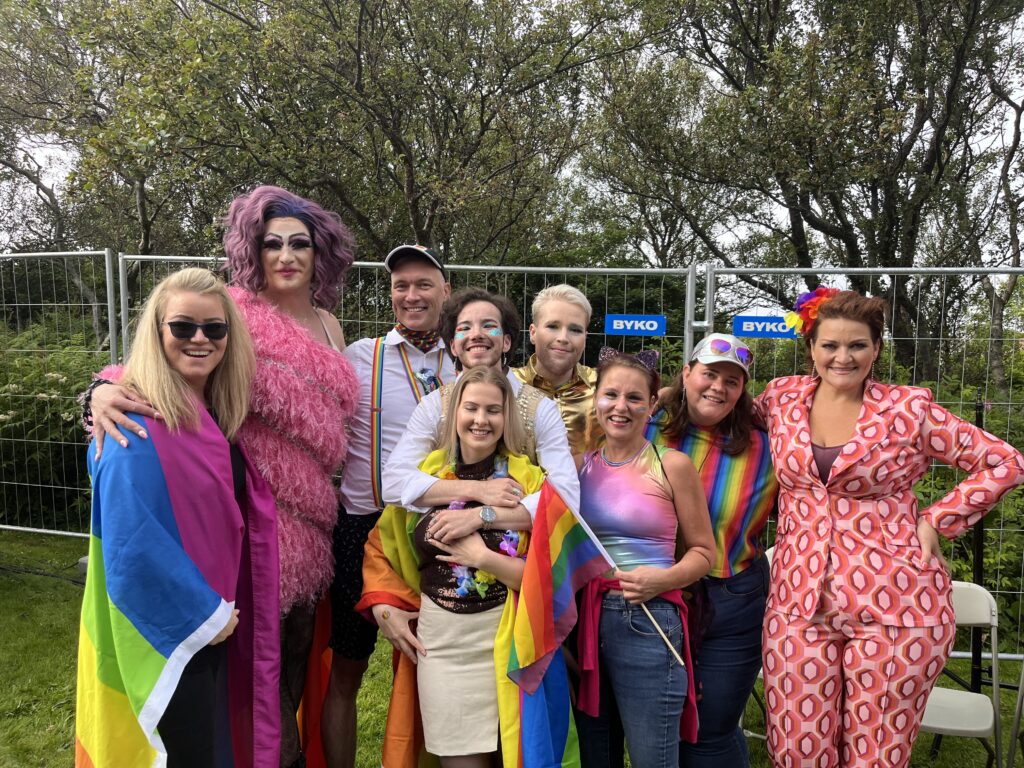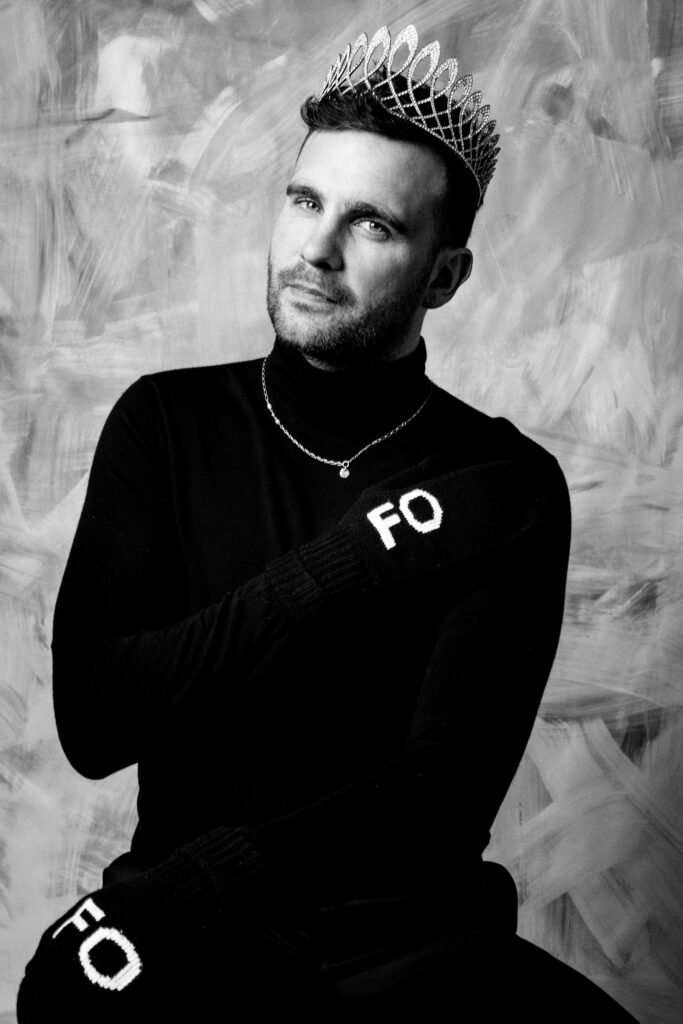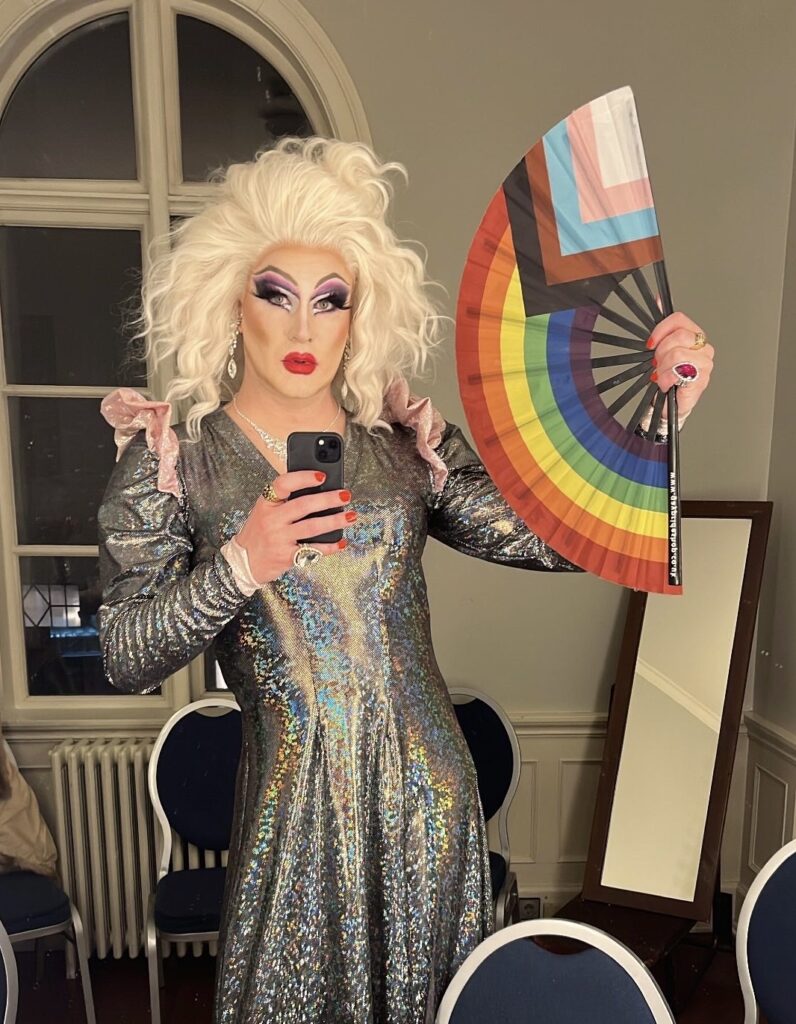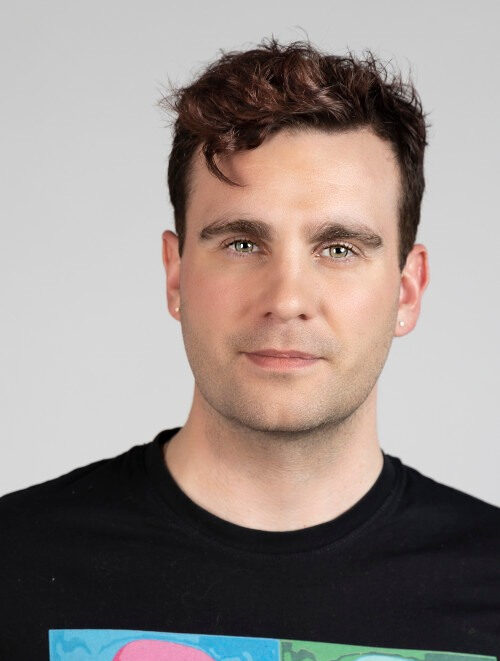Villi Ósk Vilhjálms chats about constantly coming out, exploring gender, and becoming the reigning drag queen of Iceland.
Many know Villi as a pillar within the Icelandic queer community. For years they’ve been an integral part of all sorts of events big and small. Given all the work they’ve done as a part of Reykjavík Pride and Samtökin ‘78 it’s likely you’ve attended some kind of gathering that Villi has helped organize, performed at, or DJ’ed.
Last summer, Villi changed their pronouns to “they/them” to better reflect their gender identity. The impetus for the change came from their interview in the annual Reykjavik Pride magazine. Every year the board of Reykjavík Pride puts out a magazine detailing the program for the festival and sharing interviews with prominent queer Icelanders. Last year’s edition featured an in depth conversation with Villi about their alter ego, Lady Zadude, and Lady’s rise to the throne in Iceland’s Drag Competition. Villi says the interview went great but it wasn’t until after they got a draft of the article that things became uncomfortable.
“I got the interview back and saw ‘he’ being used a few times and it just bothered me too much. I thought because the magazine is a written out, printed thing that couldn’t be changed afterward.”
At the time of publishing last year’s issue, Villi had come out as genderqueer / non-binary to some close friends and family, but it wasn’t something they were advertising or bringing up in public often.
“When the pride magazine interview was taken I was kind of coming out, in the spring of 2022, just very softly to my family at that point,” they say.
Seeing a different Villi on the page and the dissonance it created then pushed them to ask for revisions and change all the pronouns to ‘they’ to better reflect their gender.
Today Villi says that genderqueer feels right to them more so than non-binary. They say that after diving deeper into the conversation surrounding gender identity using the term non-binary still defines a person in relation to a binary world that they are not part of. Being genderqueer means they can define themselves on their own terms, outside and independent from the gender binary.
Printing queer history
For many people in the queer community the annual pride magazine also represents more than a schedule of events and fun chats with organizers; it’s a recorded form of Icelandic queer history. “If you think about it, it’s one of our very few written histories,” says Villi. “We’re writing our history with it and I knew that ‘he’ wasn’t representative of me and who I am. So then I decided to ask the editor to change it.” With all the pronouns changed Villi felt ready to give the green light on the article.
When the magazine was published and Reykjavik Pride celebrated with a pre-pride party, Villi says they suddenly realized more people would be aware of it. “I remember coming to the publishing party and somebody said ‘oh great interview with you, congrats on your new pronouns’ and I was like ‘oh yes that’s right.’ I had forgotten that but good it’s there.” They laugh. “Given my day to day relationship with ADHD I forgot to talk to some people about it.”

Although it was sort of a soft coming out, Villi says coming out as genderqueer is more of an evolving process. For instance, they haven’t been much of a stickler with their pronouns everywhere. “In certain groups I’m quite firm about pronoun usage. In other groups I’m too lazy to take the conversation sometimes.” They laugh. “With friends and family is the most important thing for me.” Like many other queer people, Villi says they don’t feel the need to explain themselves all the time; some spaces and instances warrant the introduction and others don’t demand it.
Masc vs. Femme
When it comes to how they view their gender identity and express it Villi says it’s all about being able to be femme or masc whenever they please. “If you look at the spectrum of genderqueer people, a lot of us like to be androgynous. I’m many things but I’m definitely not androgynous at the moment, most likely I’ll never be. But playing around with my gender expression is something I enjoy immensely,” says Villi.
“I don’t see myself as gender fluid. I don’t flow between male and female. […] I don’t do boxes. I’m outside of the boxes.”
Even though they’ve left the traditional ‘boxes’ of the gender binary behind, Villi says that outside queer spaces people want to put them into another box. “A lot of queer people strive for androgyny because when you’re androgynous people actually realize you’re genderqueer. If someone doesn’t know anything about being non-binary or queer they need to actually think about it. Like ‘what are they actually?’ instead of immediately being put in a box. That’s the creative beauty of being genderqueer. It’s about leaving a box. And people generally want to put you right back into a box.” They laugh.
“I express it in whatever fucking way I like”
For them, their gender identity is not about flowing between society’s norms, it’s not about bouncing between masc and femme boxes. “Even when people talk about gender fluidity – I don’t see myself as gender fluid,” says Villi. “I don’t flow between male and female. When I talk about being genderqueer people are like ‘oh so you flow between boxes.’ It’s like no, no, no. I don’t do boxes. I’m outside of the boxes. I’m not floating between them, for me the boxes don’t exist, or at least shouldn’t exist,” they clarify.
Depending on the space they’re in, Villi says their expression and appearance change, and that’s ok. “If we look at things that are traditionally femme or traditionally masc, or to use the beautiful word ‘butch’ which I love, then I would yes, say I’m more masc presenting,” says Villi. “But more often it’s like: what chances do I have for self expression?” explaining that every choice they make on a daily basis is framed by their gender and how they want to present themselves without thinking about what other people are going to say.
When it comes to their work at Samtökin ‘78 or out and about in any other part of their life, Villi says that they don’t have to perform for anyone else to understand who they are. “It’s so important to also realize that you don’t owe anybody androgyny,” they say. For them, they shouldn’t have to manipulate their appearance for anyone other than themself.

Understanding their gender identity also came with questions Villi didn’t expect to have to answer. They thought: “Am I femme enough?” Which after some more thought made them think: “Boom, we go back to those two binary gender boxes. Am I enough outside of the male box to be genderqueer? What’s the difference between me and a femme-boy?” they ponder. “The obvious answer is that I’m not a boy so that takes care of that,” they say laughing.
“I think it’s definitely a fresh new exploration that I’m having and part of the exploration and experience is finding the peace in knowing that I don’t have to be more femme than I am or be more masc than I am,” says Villi. “I can be very femme presenting tomorrow and very masc the next day and I’m still genderqueer. The genderqueer part is who I am. Then I express it in whatever fucking way I like.”
On coming out constantly
Growing up Villi identified as male and eventually came out as gay. Now that they have more perspective on their gender identity and sexuality, Villi says it makes a lot of sense that they came out as gay when they did. “A lot of genderqueer and trans people come out as gay, bi, pan, or queer before transitioning and I think we blame a lot of gender dysphoria on that, on being closeted,” says Villi. They also say that it’s not always so black and white; “you find out that it’s more than that [being closeted]. It’s more than sexuality. It’s actually about gender identity and gender expression.
It’s such a big difference, like when I came out as gay people knew immediately what that meant. They might have some prejudice or stereotypical idea of what it was, a guy loving another guy. We understand that, it’s simple” says Villi. “Then you say nonbinary or genderqueer and they’re like ‘oh ok, what on earth does that mean?’”
“I can be very femme presenting tomorrow and very masc the next day and I’m still genderqueer. The genderqueer part is who I am.”
Language plays a large role in how Villi identifies as well, because in Icelandic they can simply use “kynsegin” to explain their gender. Villi says “if you look at the word kynsegin, it covers nonbinary, gender nonconforming, genderqueer, agender, bigender, gender fluid, two spirited and more. You’re taking seven or more English words and putting them into one. People that use kynsegin can identify as both male and female, neither male or female, fluid or simply don’t define their gender at all.” Vill says in many ways it makes things simpler. “It takes pressure off. If I’m kynsegin I can just be that and try out all the English words too.”
At the same time, Villi has never felt comfortable being defined as a man. “It’s taken me a long time,” they say. “In the past I’ve thought like am I trans? Am I a trans woman? No, I don’t relate to that, I don’t want to be in the female box. I don’t belong there. I don’t feel at home in the male box either but I know I’m not female. So genderqueer gave me that freedom of ‘ok, I can step out of the box I’m in and I don’t have to step into another one.’”

It’s not one or the other, says Villi. “It’s just interesting to unpack something that society, the culture, the educational system and even part of the queer community has told you your entire life. You’re a man, you do these things that men should do. Then you come out as gay and you have a bit more freedom, an excuse for liking this or that, doing this or that. And then when the excuses run out it’s like ok, this is something more than just my sexuality, I need to take a look at my gender.”
Villi also says that every decision about how their gender expression and appearance has been given attention in this process to better represent their gender identity. “[I was holding back] expression of my gender identity,” they reflect. “I feel like in the past couple months I’ve finally opened that and gone ‘ok what does that mean?’ ‘what choices do I make when I’m not bound by something?’ Some choices I’m making again. Some choices I’m reaffirming. Others I’m like, hmm, not sure I like that.” They laugh.
These choices range from little to big and come up throughout Villi’s everyday life. “How do I dress myself? Do I wear makeup? How do I wear makeup? Jewelry, how do I pick it, how do I wear it? It’s more in relation to how I express myself. It’s also just a feeling. How do I belong in my own skin? I think I’m feeling a sense of belonging, finally, with myself,” they say. “In general I just feel more comfortable in myself, in my own skin. I’m finally at home.”
Lady Zadude, reigning drag queen of Iceland
Anyone who went to the Icelandic Drag Competition of 2022 would have noticed the winner of the competition, Lady Zadude. That lady-dude is Villi’s drag persona, who won both the competition and was voted fan favorite by the audience. Villi came crashing into the Icelandic drag scene, threw their hat in the ring, and won after only having performed in drag a handful of times before.
“I think I’m feeling a sense of belonging, finally, with myself.”
Although Villi says drag is great for exploring the boundaries of all genders, for them it was an outlet for their femme side to play around in. “Drag has made me open up and explore. Drag for me is fundamentally about gender expression and challenging how we express gender. You’re challenging so many norms by doing that and having fun with that and being comfortable with that. If you’re female doing female drag even that hyper femininity you portray gives you a chance of challenging gender norms,” says Villi.
Nowadays Villi says they need drag less and enjoy it more because their full gender identity isn’t hidden away as much anymore. Now gender euphoria isn’t reserved for the stage, but everyday life.

If you can’t love yourself, how in the hell are you gonna love somebody else?
Moving throughout the world Villi is a lot more at home with themselves. Although the past years have been about re-exploring and redefining themselves, Villi’s not feeling the weight of their gender bogging them down as much as it did.
Though they say it begrudgingly because of how cringe it may sound, Villi confirms “in general I just feel more comfortable in myself, in my own skin. It’s such a cliché thing to say,” they say laughing.


